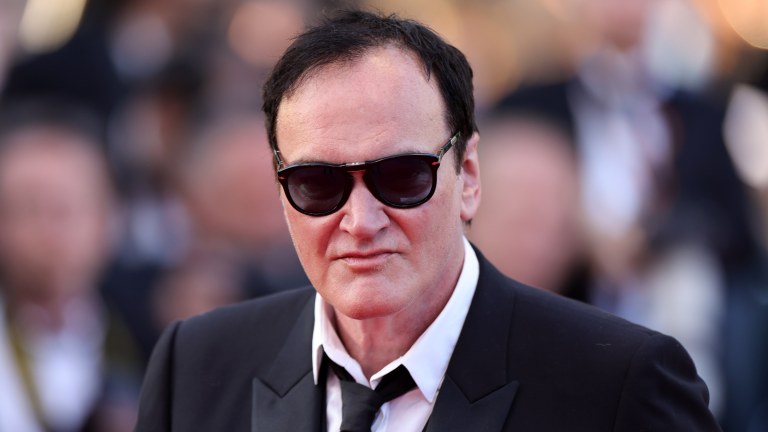The Many Quentin Tarantino Movies That Never Got Made
The Movie Critic and Kill Bill Vol. 3 aren't the only Quentin Tarantino movies that never happened.

Quentin Tarantino loves film. Few filmmakers can boast such a wide knowledge of movies, especially the B-films and grindhouse works that have inspired his greatest cinematic accomplishments. Tarantino also loves to talk about future projects. Put those two passions together and you get a guy who often teases movies he never actually ends up making.
Of course, it’s not always talk. Many of his best movies, including Kill Bill and Once Upon a Time… in Hollywood started as ideas that he blabbed about to anyone who would listen. But while that approach builds excitement, it also sets up fans for disappointment, such as when it was revealed that he had abandoned The Movie Critic, which for months was teased as the director’s 10th and final film.
Now including The Movie Critic, here are the most intriguing Tarantino projects that never got made.
Double V Vega
Perhaps the longest rumored unmade Tarantino, the Vega Brothers project would have built on his first two films, bringing together Vic Vega aka Mr. Blonde (Michael Madsen) from Reservoir Dogs and Vincent Vega (John Travolta) from Pulp Fiction. Throughout the late ’90s and early 2000s, Tarantino mentioned would mention the possibility of the movie, even at one point revealing the title Double V Vega. But that’s about all the details he would share about this project.
Much later, Tarantino revealed why he never provided more detail about Double V Vega: because those details didn’t exist. Speaking with the ReelBlend podcast in 2019, Tarantino admitted that he had only a few basic ideas and never developed more. “I don’t think I took it far enough for a story, but I had a premise,” he said.” It would have taken place in Amsterdam,” he continued, right before the events in Pulp Fiction. “At some point, in his two-year stay in Amsterdam, running some club, Vic shows up to visit him. And it would have been their weekend.”
But that’s as far as he ever got, stating, “Exactly what happens to them or what trouble they get into, I never took it that far.”
Kill Bill Vol. 3
“When you grow up, if you still feel raw about it, I’ll be waiting.” When the Bride Beatrix Kiddo (Uma Thurman) said those words to Nikki (Ambrosia Kelley), daughter of rival assassin Vernita Green (Vivica A. Fox), audiences took it as nothing more than another surprising human moment in the violent revenge picture Kill Bill Vol. 1. But during the press tour for 2004’s Kill Bill Vol. 2, Tarantino let slip ideas for a continuation.
“[I]nitially I was thinking this would be my Dollars trilogy,” he told Entertainment Weekly in 2004. But while he first intended to make a new entry every 10 years, he realized he would need “at least 15 years” before making Vol. 3, as he wanted to follow the adult Nikki looking for revenge after being raised by Sofie Fatale (Julie Dreyfus).
Tarantino got his 15 years, and then some. But 20 years later, in 2023, the director dismissed the idea, saying he was devoting his energy to The Movie Critic.
Django/Zorro
The 2012 Western Django Unchained repurposed the name of a Spaghetti Western hero for a rollicking anti-White supremacist action flick starring Jamie Foxx. As soon as 2013, Tarantino started talking about a sequel called Django in White Hell, but the beginnings of that movie eventually became The Hateful Eight.
Tarantino then returned to the character in 2014 for the seven-part comic book miniseries Django/Zorro, co-written by the legendary Matt Wagner and drawn by Esteve Polls. Set seven years after Django Unchained, Django/Zorro saw the titular gunslinger teaming with an aged Don Diego de la Vega.
The comic’s success inspired Tarantino to begin developing a film version. Not only did he recruit comedian Jerrod Carmichael to write the script, but he even got Antonio Banderas on board to reprise his role as Zorro. Little more was ever said about the project, until Carmichael gave a disappointing update to GQ in 2022, revealing that they had written “a $500 million film,” admitting that he realized “the impossibility of it.”
Luke Cage: Hero for Hire
Although superhero movies these days tend to be formulaic, that wasn’t always the case. In the late ’90s and early 2000s, filmmakers such as Ang Lee and Sam Raimi could bring their idiosyncratic visions to the world of tights and capes. During that era, Tarantino saw himself taking a crack at the genre. In a 2020 appearance on Amy Schumer’s podcast 3 Girls, 1 Keith, Tarantino recalled “a time before all this Marvel shit was coming out” when he “had thought about doing Luke Cage.”
Luke Cage makes a lot of sense for Tarantino, given the character’s roots in the same Blaxploitation cinema that the director integrated into his movies. Tarantino is also a longtime fan of the character, along with Shang-Chi and the books Werewolf by Night, and Tomb of Dracula, which featured the vampire hunter Blade.
Tarantino took a meeting with producer Michael Pressman, who owned the Cage adaptation rights in the ’90s, and even started thinking about casting Laurence Fishburne in the lead role. But as he told Schumer and her co-hosts, his comic geek friends disapproved of the idea, favoring Wesley Snipes as the Hero for Hire, and he lost interest, proving once again that demanding fans ruin everything.
Casino Royale
Bond fans know Casino Royale as not only the Ian Fleming novel that introduced 007, but also as the title of two films. The 1967 movie stars David Niven as Bond, one of Fleming’s original choices to portray the character, but plays as an unfunny parody of the nascent franchise. The 2005 film that rebooted the series starred Daniel Craig as a more brutal but also more human 007.
In between those two, Tarantino considered making his own version. While serving on the jury for the 2004 Cannes Film Festival, the director shared his love of Bond and even admitted to pitching an idea to then-007 Pierce Brosnan. “I would like to do the original book Casino Royale and do it more or less the way the Ian Fleming book is,” Tarantino explained to BBC News. Eon, of course, liked the idea of adapting that book, but not with Brosnan still in the role and certainly not as a film set in the ’60s. And so they chose Martin Campbell to direct the official adaptation of the book, creating one of the best entries in the franchise.
The Killer Inside Me
Written by Jim Thompson, the novel The Killer Inside Me shocked readers when it released in 1952. The 2010 film adaptation directed by Michael Winterbottom continued that trend, with critics and audiences decrying its extreme mayhem. One can only imagine what Tarantino would have done with the material had he followed through with his plans to bring the book to screen in the early 2000s.
A fan of Thompson from youth, the director paid homage to the writer throughout his career, most notably by integrating the last chapter of The Getaway into his script for From Dusk Till Dawn. Thanks to the success of Pulp Fiction, Tarantino had the sway to make a book-accurate version of The Killer Inside Me, and even cast Juliette Lewis and Brad Pitt. According to critic Stephen Dalton, the political climate after 9/11 scared studios off from the project and Tarantino went onto other things.
Rambo
Every budding cinephile know-it-all loves to point out that the first Rambo movie, First Blood, featured a sympathetic portrayal of a Vietnam vet with PTSD, far removed from the jingoistic action spectacles that Sylvester Stallone would go on to make later. Even then, it’s surprising that Tarantino would consider adapting the book by David Morrell, even after deciding that he would stop acting like an auteur and just make “a good movie.”
Tarantino shared the details regarding the version of the Rambo movie he’d like to make on The Big Picture podcast in 2021: “I would do the novel,” he told the hosts. “And Kurt Russell would play the sheriff, and [Adam Driver] would play Rambo.” Of course, Tarantino pitched the idea as something he would do after his 10th movie, which means that he probably never took it seriously.
Killer Crow
Beyond their obvious action movie delights, the big thrill of Inglourious Basterds and Django Unchained is how they revise history. Even the most hardened stickler for historical accuracy cannot help but cheer when the Basterds obliterate Hitler or when Django slaughters enslavers.
Tarantino intended to complete his trilogy of revisionist history films with a more direct sequel to Inglourious Basterds, titled Killer Crow. In fact, as he explained to author Henry Louis Gates Jr., Killer Crow would have fleshed an idea that he originally had for Inglourious Basterds, which “followed a bunch of Black troops, and they had been fucked over by the American military and kind of go apeshit.” The film would see these soldiers “go on an Apache warpath and kill a bunch of white soldiers and white officers on a military base and are just making a warpath to Switzerland.” The Inglorious Basterds would have also made an appearance in the movie.
Although he claimed in 2012 that he had part of a Killer Crow script “ready to go,” Tarantino has never returned to the idea.
Star Trek 4
Easily the most infamous of his unmade projects, Tarantino has long played with the idea of a Star Trek film. And in its desperation to bring something to the screen after 2016’s Star Trek Beyond, Paramount Pictures considered the idea, regardless of how much of a mismatch Tarantino’s style is for something like Trek.
A self-described “huge fan” of Chris Pine, Tarantino planned to bring his unique approach to period pieces to the Kelvin franchise, with Pine as Kirk and Zachary Quinto as Spock. Rumors suggested that it would adapt the episode “A Piece of the Action” from The Original Series, in which the Enterprise encountered a planet modeled after 1930s America.
The movie gained a lot of traction, and Tarantino even finished a script for the project, co-written by Mark L. Smith, writer of The Revenant. Even though the movie’s violence and language would have likely earned his Star Trek an R-rating, that wasn’t what prevented the project from coming to fruition. Instead, it was Tarantino’s 10-film rule and his reluctance to end his career with a franchise picture.
The Movie Critic
All of this brings us to The Movie Critic, which truly seemed like it would close out the director’s remarkable career in movies. As with most of his projects, Tarantino had been talking about The Movie Critic for years before taking it seriously, tossing around ideas about a movie set in the 1970s. Eventually, that developed into the story of a small-town critic writing reviews for a pornographic magazine, and later morphed into a movie that would see Brad Pitt reprise his role as stunt man Cliff Booth from Once Upon a Time… In Hollywood. According to Deadline, Tarantino changed his mind about the project after rewriting the script.
Where does that leave us now? It’s unclear. Tarantino is still talking about only making 10 movies, but that’s an arbitrary number that’s a limit he decided to impose on himself and can change at any time. Whatever he decides to do, it’s clear that Tarantino has plenty of options for his 10th film.
